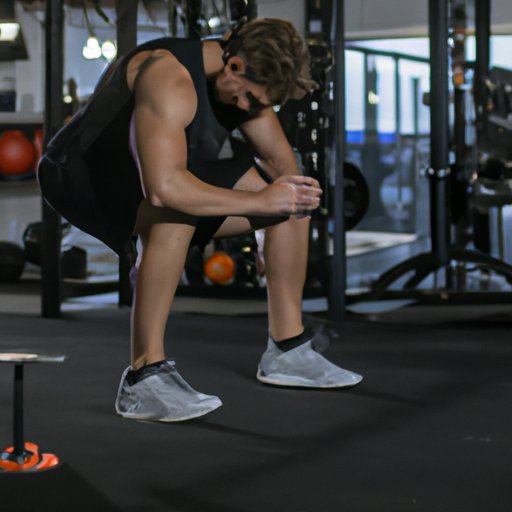Introduction
Cutting in the gym refers to a strategy used for reducing body fat and gaining muscle definition. It involves creating a calorie deficit through diet and exercise while also engaging in strength-training workouts that target multiple muscle groups. Cutting can help people achieve their desired physique and improve overall health.
Start with a Warm-Up
Starting your workout with a warm-up is essential for cutting in the gym. Warming up helps to reduce the risk of injury by gradually increasing your heart rate, raising the temperature of your muscles, and preparing your body for more intense activity. Studies have found that performing a dynamic warm-up before lifting weights can significantly improve performance, power output, and muscular endurance.
Examples of warm-up exercises include jogging, jumping jacks, lunges, arm circles, shoulder rolls, and bodyweight squats. Aim to perform each exercise for at least 30 seconds or 10-15 repetitions.

Choose Exercises that Target Multiple Muscle Groups
Compound exercises are a great way to maximize the results of your cutting routine. These exercises involve multiple joints and muscle groups, allowing you to target multiple areas of the body with one exercise. Compound exercises help to increase strength, build lean muscle mass, and burn more calories.
Examples of compound exercises include squats, deadlifts, bench presses, bent-over rows, pull-ups, and push-ups. Aim to perform 3-4 sets of 8-12 repetitions for each exercise.
Increase Intensity
Increasing intensity is important for cutting in the gym. High-intensity workouts help to burn more calories and increase muscle definition. Research has shown that high-intensity interval training (HIIT) can be more effective for fat loss than steady-state cardio.
Tips for increasing intensity include lifting heavier weights, decreasing rest time between sets, adding resistance bands or weights to bodyweight exercises, and performing supersets (two exercises performed back-to-back). Aim to complete 2-3 sets of each exercise at the highest intensity possible.
Focus on Short Rest Periods
Short rest periods are essential for cutting in the gym. Taking too long of a break between sets can decrease the effectiveness of your workout and reduce calorie burn. Studies have found that short rest periods (30 seconds or less) can lead to greater gains in strength and muscle growth.
Tips for taking short breaks between sets include using a timer, counting out loud, or setting a goal for the number of reps you want to complete before taking a break. Aim to take no more than 30 seconds of rest between sets.
Monitor Your Diet
In order to successfully cut in the gym, it’s important to monitor your diet. Eating nutrient-dense foods will ensure that your body has enough energy to fuel your workouts and promote muscle growth. Aim to eat a balanced diet that includes plenty of lean proteins, healthy fats, complex carbohydrates, fruits, and vegetables.
Examples of healthy foods to include in your diet include lean meats, fish, eggs, nuts, seeds, legumes, whole grains, fruits, and vegetables. Aim to get at least 20-30 grams of protein with each meal.
Incorporate High-Intensity Interval Training
High-intensity interval training (HIIT) is a great way to boost your metabolism and burn more calories. HIIT involves alternating periods of high-intensity exercise with low-intensity recovery periods. Studies have found that HIIT can be more effective for fat loss than steady-state cardio.
Examples of HIIT exercises include sprints, jump squats, burpees, mountain climbers, and plyometric push-ups. Aim to perform 3-4 HIIT workouts per week for 15-20 minutes.
Track Your Progress
Tracking your progress is an important step for cutting in the gym. Keeping track of your workouts and diet can help you stay motivated and make adjustments to your routine as needed. Studies have found that tracking progress can lead to greater adherence to an exercise program and improved outcomes.
Tips for tracking progress include taking pictures of yourself, keeping a food journal, and measuring your body fat percentage. Aim to track your progress at least once a month.
Conclusion
Cutting in the gym is a great way to reduce body fat and gain muscle definition. It involves creating a calorie deficit through diet and exercise while engaging in strength-training workouts that target multiple muscle groups. To maximize your results, start with a warm-up, choose compound exercises, increase intensity, focus on short rest periods, monitor your diet, incorporate HIIT, and track your progress. With consistent effort, you can reach your goals and achieve your desired physique.
(Note: Is this article not meeting your expectations? Do you have knowledge or insights to share? Unlock new opportunities and expand your reach by joining our authors team. Click Registration to join us and share your expertise with our readers.)
